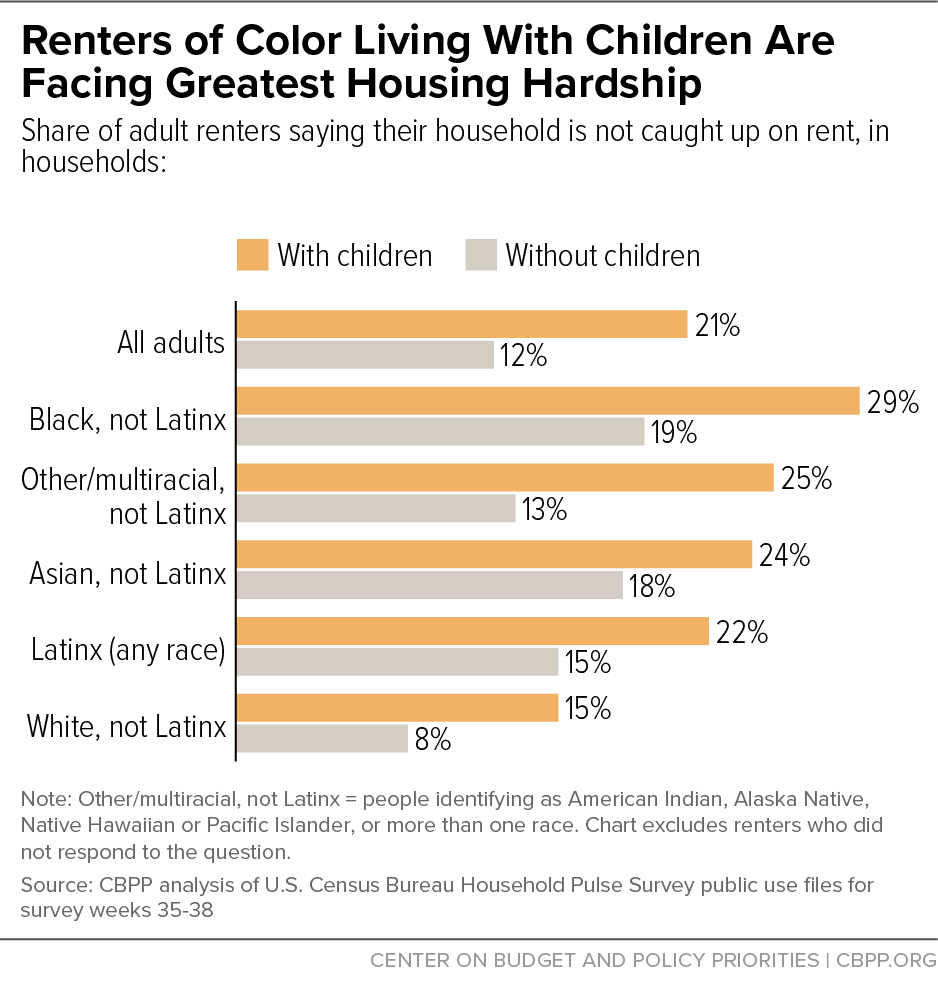One of the most important investments to support every child’s current and future well-being is to ensure they have safe, stable housing. The Build Back Better legislation that Congress is considering includes a significant step toward that goal: $24 billion for Housing Choice Vouchers. Vouchers and other rental assistance programs are highly effective at reducing homelessness, housing instability, and overcrowding, which all harm children and their families. Rigorous research shows that receiving a voucher can have profound benefits for a child’s mental and physical health and educational success, and it can help keep families together by reducing placements in foster care.
Housing vouchers help households with low incomes rent a modest unit of their choice in the private market. Build Back Better’s proposed $24 billion voucher program investment, once fully phased in, would help make homes affordable for an estimated 300,000 households with low incomes — including about 274,000 children. About 80,000 of the new vouchers would be specifically for families and individuals at risk of or experiencing homelessness and for survivors of domestic violence or human trafficking.[1]
Although Build Back Better offers a meaningful step forward to reduce housing instability, the expansion of the program would still leave out millions of eligible families. Congress can further expand housing vouchers and reduce housing hardship through the annual appropriations process. President Biden’s budget request for 2022 included significant funding for additional vouchers, and the House in July passed a yearly spending bill that would provide about 125,000 additional new vouchers. As policymakers look to finalize their appropriations bills, they should finalize this investment and take every opportunity to ensure that families with children and other households can afford a secure home.
Due to funding limitations, vouchers and other rental assistance programs now only reach about 1 in 4 eligible households. Assistance for families with children is particularly needed. About 1.7 million low-income families with nearly 3.8 million children receive a voucher or other rental assistance, but nearly 5.3 million eligible renter households with children are left unassisted.
Millions of children were already experiencing housing hardship before the pandemic worsened the problem. On average, 1 in 5 renters living with children reported that they were behind on rent in August–September 2021. These housing problems are concentrated among families of color due to a long history of racist policies and ongoing discriminatory practices, such as employment discrimination and disinvestment in communities segregated through government action, that have limited their economic and housing opportunities.
In addition to helping children and families secure stable housing, vouchers make other investments in children more effective. Vouchers provide additional choice for families to live near specific child care or schools that best suit their needs and reduce the amount families dedicate to rent, allowing them to spend more on food, health care, and supports for their children.[2] For children in families with low incomes, housing instability can undermine investments in education, forcing children to change schools and, the evidence suggests, hindering their school performance.
The pandemic and economic downturn caused millions of households to fall behind on rent. Renters who live with children have consistently been more likely to be behind on rent than adults not living with children. From early August to late September of 2021, an average of 21 percent of renters living with children were not caught up on rent, compared to only 12 percent of renters without children in their household. That’s an estimated 5.7 million households living with children that were not current on their rent. Due to the systemic barriers mentioned above, renters of color living with children are even more likely to be behind on rent, particularly Black households with children. (See Figure 1.) And 2.6 million (46 percent) of renters living with children that are behind on rent said they believe eviction is somewhat or very likely in the next two months.[3]
And while the pandemic has undoubtedly exacerbated hardship for children and their families, many of them were already experiencing some form of housing instability. Before the pandemic, nearly 8 million children were part of low-income families that spent more than half of their income on rent and utilities.[4] More than 1.3 million children who attend public schools experienced homelessness or lived doubled up with another family (often in overcrowded and unstable housing arrangements) at some point during the 2018-2019 school year.[5] (See Figure 2.) And for the first time since communities nationwide began collecting these data for their annual point-in-time counts, the number of families with children experiencing unsheltered homelessness increased from January 2019 to January 2020.[6]
This annual count also found that more than half (53 percent) of all families with children experiencing homelessness were Black, reflecting a long history of discrimination in housing, employment, and beyond that has led to Black people and other people of color being more likely to rent their homes, to pay more than half of their incomes on rent, and to experience homelessness.
A broad body of research links homelessness, housing instability, overcrowding, and poverty to adverse effects on children’s health, development, and school performance. Evictions, doubling or tripling up with other families, and other forms of housing instability can force families to frequently move. Frequent moves are linked to attention and behavioral problems among preschool children, and homelessness is associated with physical and mental health issues, injuries, and poor school performance. Studies find that children living in crowded homes score lower on reading tests and complete less schooling than their peers.[7] One estimate found that families with children experiencing housing instability accrued $8 billion in avoidable health care and education costs in 2016.[8]
The Housing Choice Voucher program enables families to rent private-market housing for about 30 percent of their income. (Anyone paying above that threshold is considered “cost burdened,” and anyone paying more than 50 percent is severely so.) The voucher program reduces homelessness, housing instability, overcrowding, and poverty and has far-reaching implications for other aspects of families’, and children’s, lives.[9] For example, children whose families are homeless and receive vouchers to rent housing are less likely than a control group to be placed in foster care or to experience sleep disruptions and behavioral problems. They are also likelier to exhibit positive social behaviors such as offering to help others or treating younger children kindly.[10]
Vouchers can also reduce how frequently children change schools, which is particularly important for students with disabilities who receive individualized education services. Vouchers improve test scores for at least some groups of children,[11] and teenagers had higher earnings as adults (relative to a control group) for each additional year their family used a voucher or lived in public housing, researchers have found.[12] By lowering rental costs, vouchers also enable people with low incomes to spend more on other basic needs like food and medicine, as well as on goods and services that enrich their children’s development, including additional health and educational resources for children with disabilities.
Vouchers have additional benefits when they enable families to move to lower-poverty neighborhoods if they choose. A rigorous study found that children whose families used vouchers to move from high- to low-poverty neighborhoods — which generally have better-resourced schools — had substantially higher adult earnings and rates of college attendance than similar children whose families stayed in neighborhoods that have higher rates of poverty and receive fewer investments.[13]
Despite the proven successes of housing vouchers, just 1 in 4 eligible families receive any type of federal rental assistance due to funding limitations, and the number of families with children who receive federal rental assistance has fallen in recent decades, despite rising need. While the overall number of households with rental assistance has stayed roughly flat, the share of assistance going to families with children has declined, partly because newly available vouchers have primarily targeted veterans experiencing homelessness and people with disabilities.[14] Currently, about 1.7 million low-income families with nearly 3.8 million children receive a voucher or other rental assistance, but nearly 5.3 million eligible renter households with children are left unassisted.[15]
Providing vouchers to all who are eligible, as President Biden proposed during his campaign, could cut the child poverty rate by a third, moving 3.4 million children above the poverty line and lifting 1 million out of deep poverty, according to one study. Poverty would fall most for children of color, particularly non-Latinx Black and Latinx children.[16]
The Build Back Better legislation offers a step toward reaching President Biden’s campaign goal. The bill includes $24 billion for Housing Choice Vouchers (and an additional $2 billion for other rental assistance programs) specifically for households with extremely low incomes (defined as below the federal poverty line or 30 percent of the area median income, whichever is higher). Of the $24 billion, $7.1 billion is for vouchers targeted to people at risk of or experiencing homelessness and survivors of domestic violence and trafficking. This expansion would help about 274,000 children and their families — as well as 137,700 people with disabilities and 75,500 older adults — afford stable housing that meets any of their accessibility needs. Approximately 70 percent of people served through this expansion would be people of color.[17]
The bill also sets aside $300 million to enable housing agencies to provide robust services to help families with children and other households rent housing in a wide range of neighborhoods, as well as $230 million for measures to encourage landlords to rent to people using vouchers. Together with the expansion of the voucher program, these resources would help families with children live in the neighborhood of their choosing.
Congress is also working to finalize the annual appropriations bills for 2022, which offer another opportunity to fund new housing vouchers and thereby reduce the number of children living in shelters or motels, on the street, or in overcrowded homes. President Biden included in his budget request $1.55 billion for about 200,000 new vouchers, and the House passed a spending bill in July with $1 billion to fund about 125,000 additional vouchers. These proposals also include significant funding for services to help households use vouchers. The Senate has also proposed some resources for new vouchers targeted specifically to families with children. Policymakers should pass both Build Back Better and an appropriations bill with funding for new vouchers at least at the level in the House spending bill. These actions would help hundreds of thousands of children and be a critical step toward ensuring all of the millions of children, their families, and other households facing housing insecurity have a safe and affordable place to live.


